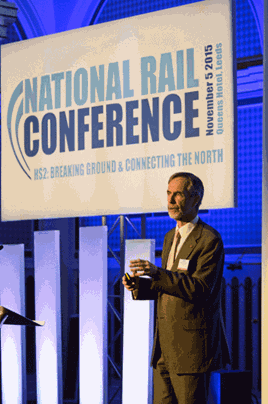A high-speed railway offers opportunities. The improvements in connectivity, and the benefits that they bring, have the potential to transform cities.
Using proven technology, HS routes can bring positive change not just for a city, but a region, and even a country. That is what High Speed 2 is really about. Rail Minister Claire Perry offers a vision of the positive change and great opportunities HS2 will offer, but what about the view from those charged with designing and building it?
Professor Andrew McNaughton is HS2 Ltd’s Technical Director. In his home city of Leeds, he spoke eloquently about the possibilities that HS2 will bring. He also highlights Birmingham, stating: “Birmingham interchange is, of course, close to the most central airport in the country. But that’s not really what it’s about, it’s about Solihull and a Solihull idea, not an HS2 idea. It’s about creating a new sustainable city which is more central for the UK.”
McNaughton discusses capacity on the current network. It’s worth remembering that since privatisation the number of yearly passengers using the railway has increased from 800 million to more than 1.6 billion. This has all been over a network that was built in Victorian times, and while there have been upgrades and capacity improvements, sooner or later it was bound to need more capacity.
And the population is growing. In 2008, the population of Great Britain was 52 million. In 2033 it is expected to have risen to 60m and in 2050 it will likely be 70m. McNaughton highlights that there are 41m people living in city regions today, and that is projected to rise to 61m by 2050.
Says McNaughton: “With all that growth, of course, we are at capacity, but bursting with opportunity.” The capacity afforded by HS2, he says, is the same as two motorways, and yet HS2 could be a twin-track railway. “And it’s about boosting this connectivity between cities.”
He wants a railway that people feel they can rely on, too. “It’s no good if you can’t rely on it. This is the way people should travel between cities in the 21st century.”
He highlights that HS2 has a very challenging specification, but points out that high-speed railways are not new. It’s proven, 51-year-old technology. Since 1964, almost 25,000km of high-speed track has been laid around the world. By 2024 that is expected to be around 37,000km, with HS2 adding to that figure two years later.
“This the first 21st century railway so we’re not designing it like a 19th century railway; we’ve designed it virtually.” He says that HS2 Ltd has constructed a virtual railway prototype, which is helping HS2 to predict and visualise the project’s results. When it is built, it must be built to last. And surely, the next generation of railway must at least match the longevity of our Victorian system? “What we build, operate and maintain is for the next 150 years,” says McNaughton. “Everything about that railway is first being created digitally.
“When we go and talk with people about the effects of High Speed 2, we don’t show them a plan and engineer’s drawing, because unless you’re an engineer, it’s meaningless. We take a tablet PC and show them a virtual image of what a particular element of the railway will really look like in situ.”
He highlights the need to innovate, to build HS2 in a new and different way, and learn lessons from the mistakes of past projects. Ignoring them and not embracing new technology would be perilous, he explains.
“We’re not going to do that. And we’re not going to do it the way it’s always been done. So many people in my team have never built a railway before and this will bring a fresh approach.”
With the virtual prototyping software that the company uses, it is possible to show stakeholders rendered images showing every single effect, every embankment, cutting and plot of land affected by the railway. The technology enables HS2 to show what the exact effect will be on people in that area, how long it will take to construct the railway, and the cost and profile of the infrastructure.
One of the major criticisms is disruption to the countryside. HS2 Ltd has never shied away from these arguments, and always sought to highlight what is being done to mitigate these concerns.
McNaughton is matter-of-fact about the issue: “We value our countryside and getting that balance has been a huge part of our work. We are creating the most environmentally sensible railway in the world because we want to, not because we have to.”














Comment as guest
Comments
No comments have been made yet.